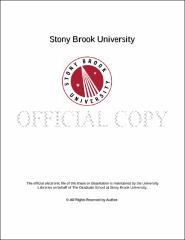| dc.identifier.uri | http://hdl.handle.net/1951/60224 | |
| dc.identifier.uri | http://hdl.handle.net/11401/71491 | |
| dc.description.sponsorship | This work is sponsored by the Stony Brook University Graduate School in compliance with the requirements for completion of degree. | en_US |
| dc.format | Monograph | |
| dc.format.medium | Electronic Resource | en_US |
| dc.language.iso | en_US | |
| dc.publisher | The Graduate School, Stony Brook University: Stony Brook, NY. | |
| dc.type | Dissertation | |
| dcterms.abstract | This dissertation investigates a history of representation of emotions in the British long eighteenth century and in the context of a rising textual culture. I do so by tracing the trope of sympathy, which is pervasive in eighteenth-century writings such as aesthetic treatises, moral philosophy, and Romantic poetry. Sympathy builds sociality through the communication of feelings and is enacted in the practices of reading, writing and representation, all of which were changing drastically as everyday life was increasingly saturated with textual media. In the process, individual emotions have to be "flattened" (Adam Smith's word) so as to be communicable, while at the same time, literary culture constructs the deep interiority of an emotional self. These developments enable the rise of political economy and psychoanalysis in the nineteenth century. As a historical project, the dissertation is largely organized chronologically. Chapter One examines Edmund Burke's aesthetic theory of the sublime. Burke emphasizes the acoustic dimension of words in communicating aesthetic feelings of sympathy. Chapter Two outlines a brief etymological history of the inward turn of emotions and sentimentality in the eighteenth century Britain. Chapter Three analyzes David Hume's moral philosophy of passions. I argue that Hume, by establishing himself as a "man of feeling," attempts to domesticate as individualistic feelings that had been understood as impersonal and contagious. Chapter Four presents the phenomenon I call "poetic mediality" in the work of William Wordsworth. Here the oral and acoustic performance of feelings gendered as feminine is poeticized so that scopic desire is generated through the act of reading presented as anthropological speculation. Chapter Five explores Adam Smith's moral philosophy of sympathetic sentiment. Smith's definition of a theatrical impartial spectator in a representational economy (in his writings on moral sentiments) makes self analogous to an exchangeable commodity (in his political economy writing) and anticipates the deep (sub)consciousness of interiority in psychoanalytic writings of the late nineteenth century. As an extended comparison and contrast with this Western history, my final chapter turns to examine late imperial Chinese pictorial culture in its imbrication with a "print modern" Chinese Enlightenment discourse of the New Culture movement, where I argue that the representation of crowds' activities of absorption and theatricality present an emergent form of subjectivity. By traversing divergent genres of writing and different cultural media, I delineate a genealogy of the emotional self shaped by the material practice of a rising textual culture. The project challenges existing versions of more abstract histories of emotion as well as sociological approaches to media studies, both of which present clear and clean histories at the expense of specific and concrete historical practices. Throughout, my project works (1) to explore the rise of visuality through a modern literary medium and how it co-evolves with orality and aurality in representing self; (2) to historicize and thus radicalize the work of writing in the fabrication of interiority; (3) to contribute a comparative approach to historical studies of media and modern literatures. | |
| dcterms.available | 2013-05-24T16:38:15Z | |
| dcterms.available | 2015-04-24T14:47:44Z | |
| dcterms.contributor | Livingston, Ira, Man-Cheong, Iona | en_US |
| dcterms.contributor | Livingston, Ira | en_US |
| dcterms.contributor | Man-Cheong, Iona | en_US |
| dcterms.contributor | Harvey, Robert | en_US |
| dcterms.contributor | Wakankar, Milind | en_US |
| dcterms.contributor | Lam, Ling Hon | en_US |
| dcterms.creator | Jiang, Wentao | |
| dcterms.dateAccepted | 2013-05-24T16:38:15Z | |
| dcterms.dateAccepted | 2015-04-24T14:47:44Z | |
| dcterms.dateSubmitted | 2013-05-24T16:38:15Z | |
| dcterms.dateSubmitted | 2015-04-24T14:47:44Z | |
| dcterms.description | Department of Comparative Literary and Cultural Studies | en_US |
| dcterms.extent | 321 pg. | en_US |
| dcterms.format | Monograph | |
| dcterms.format | Application/PDF | en_US |
| dcterms.identifier | http://hdl.handle.net/1951/60224 | |
| dcterms.identifier | http://hdl.handle.net/11401/71491 | |
| dcterms.issued | 2011-12-01 | |
| dcterms.language | en_US | |
| dcterms.provenance | Made available in DSpace on 2013-05-24T16:38:15Z (GMT). No. of bitstreams: 1
StonyBrookUniversityETDPageEmbargo_20130517082608_116839.pdf: 41286 bytes, checksum: 425a156df10bbe213bfdf4d175026e82 (MD5)
Previous issue date: 1 | en |
| dcterms.provenance | Made available in DSpace on 2015-04-24T14:47:44Z (GMT). No. of bitstreams: 3
StonyBrookUniversityETDPageEmbargo_20130517082608_116839.pdf.jpg: 1934 bytes, checksum: c116f0e1e7be19420106a88253e31f2e (MD5)
StonyBrookUniversityETDPageEmbargo_20130517082608_116839.pdf.txt: 336 bytes, checksum: 84c0f8f99f2b4ae66b3cc3ade09ad2e9 (MD5)
StonyBrookUniversityETDPageEmbargo_20130517082608_116839.pdf: 41286 bytes, checksum: 425a156df10bbe213bfdf4d175026e82 (MD5)
Previous issue date: 1 | en |
| dcterms.publisher | The Graduate School, Stony Brook University: Stony Brook, NY. | |
| dcterms.subject | Comparative literature--Modern literature--British and Irish literature | |
| dcterms.subject | Emotion, Media History, Modern Literature, Work of Writing | |
| dcterms.title | Emotion and the Work of Writing: The Making of Modern Literature in Media History | |
| dcterms.type | Dissertation | |

